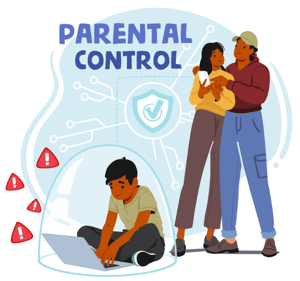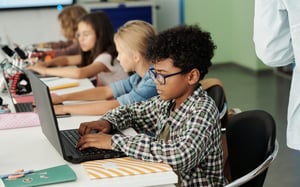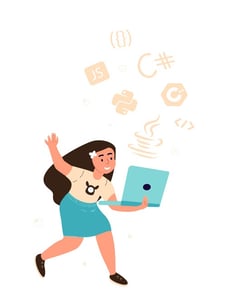Table of Contents
Coding for Kids: The Ultimate Guide for Parents in 2025
Coding for kids – otherwise know as computer programming for kids – is widely considered a mission critical 21st century skill. With how dependent society has become on technology (even more so in the age of AI), it is no surprise that more and more parents are deciding to give their kids a technical education early in life.
A survey of professionals from March 2025 indicated that over 75% of people believe that learning coding is an important skill in the age of AI. An overwhelming 90% of U.S. parents would like coding for kids to be a part of school curricula.
In this guide, we’ll discuss coding for kids: the benefits, the statistics, and why this particular brand of computer literacy is so important.
(And if you’re interested in a deeper dive into why coding for kids in the age of AI, check out my blog Introduction to Artificial Intelligence for Kids.
What is Coding?
Coding (or programming) is a creative process executed by computer programmers wherein they tell a computer or machine how to perform a specific task. It involves writing executable scripts using computer programming languages like Java, Python, or JavaScript.
Some see coding as a way of communicating with computers. Programmers give computers instructions, and the computer carries them out. People who know how to code (i.e., coders, programmers, developers) can create games, apps, computer software, websites, and interactive digital content.

Should kids still learn to code in the Age of AI?
Absolutely. Coding is more relevant now than it has been before during the Age of AI. Sure, AI tools such a Chat GPT and GitHub Copilot can auto-generate code, but an individual’s comprehension of the building blocks of coding will always be a differentiator for students (and professionals alike).
Here are some reasons coding is still relevant:
AI is a tool not a logic replacement.
AI can assist you in writing code, but it does not take away the need to know how code actually works. There will always be an advantage for individuals who can think computationally and create smart logic to debug errors as opposed to simply relying on what an AI tool tells them.
Customizing and understanding solutions will still require coding knowledge.
In most cases, AI-generated code does require some level of updating, editing, optimizing, or debugging. When you know how to code you can identify when something “didn’t work”, improve it, change it, and customize a solution to your needs.
Innovators will be builders of technology, not just consumers.
The future generation of tech leaders will not only be applying AI to their visions, they will be building it. Learning how to code is the way to build new applications, customize AI or machine learning models, and reshape the future of technology as we know it.
Coding builds critical thinking and systematic problem solving.
The skills you learn from coding can be used across disciplines; whether medicine, finance, design or education, the formal mindset of thinking systemically and logically that coding teaches will be a huge advantage.
Ultimately, AI asks the right questions, but coding is the language of the future. When kids and teens learn to code, it is not only preparing them to thrive in AI, but to lead it too.
Top 10 Kids Coding Platforms in 2025
With the ever-growing importance of technology in our world, it’s no surprise that more and more parents are looking for ways to give their children a leg up by teaching them coding. And there are plenty of great options out there! Many online programs offer courses specifically tailored for kids, with fun exercises and games that make learning coding fun and engaging.
Below is a list of our top 10 favorite coding platforms and services in 2025. I have been also to be sure to label platforms and services that have incorporated teaching students modern software engineering with AI as a code partner.
CodaKid
CodaKid is a great way for kids to learn how to use real programming languages and professional tools by creating games, coding apps, programming drones, building websites, and more. CodaKid has taught over 100,000 kids and teens how to code, and since 2014 they have won a number of industry awards including CODiE Finalist for Best Coding and Computational Thinking Solution and a Parents’ Choice Gold Award.
CodaKid starts beginners with Scratch and other visual block coding tools. Older or more advanced students can take Core which offers tracks in Python programming, Roblox Game Development with Lua, Minecraft Modding with Lua, and more. Their electives include Artificial Intelligence, Web Development, Advanced Python, and 3D Game Development with Unity and Unreal Engine.
CodaKid’s innovative Kids AI track teaches kids how to build real AI projects with professional tools and programming languages, including using APIs for automations and agentic AI projects
The online coding school is a great fit for everyone because it allows you to learn at your own pace, providing a great way for kids to learn how to code with their self-paced courses and 1-on-1 online lessons. Your kids will have access to awesome support from a team of engineers and teachers who can help your child solve any problems. The 1-on-1 option allows them to get the individualized attention needed to succeed.
CodaKid is recommended for ages 6 to 18
Juni Learning
Juni Learning is an excellent kids coding academy that specializes in private online tutoring in coding, AI, and test preparation. Their curriculum is well-designed and they run a well-run online academy that has garnered excellent reviews.
Juni’s curriculum starters with Scratch for younger learners while they begin with Python for older, more advanced students. They additionally offer electives in Java and Web Development.
Juni’s coding platform hosts both their online lessons as well as asynchronous homework assignments using pre-recorded video.
Juni Learning is recommended for ages 8 to 18
Coding with Kids
Coding with Kids is a kids coding academy that specializes in online, instructor-led classes and live, in-person classes in a growing number of markets in the US. Why I like them is that they have a Coding Ladder that takes kids from the very basics to high level vocationally focused coding classes in a well-planned, multiyear system.
Coding with Kids offers private 1:1 tutoring as well as small group formats, and they offer a series of online and in-person summer camps on exciting topics such as Roblox Game Development, Python programming, and more.
Coding with Kids is recommended for ages 6 to 18
Code Monkey
Code Monkey is a website that teaches kids coding through playful online games. In these games, children write code with the goal of helping a monkey gather bananas. As they play, they learn all of the important coding concepts such as logic, loops, direction, sequencing, and algorithms. As a result, Code Monkey is an excellent resource for teaching kids the basics of coding in a fun and engaging way.
The games on Code Monkey are carefully designed to introduce new concepts in a way that is easy for children to understand. And because they’re having so much fun playing the game, they don’t even realize they’re learning! If you’re looking for a way to teach your child coding, Code Monkey is a great option.
Tynker is best suited for school environments, as their self-guided approach keeps kids “on rails” and they rarely get stuck or need help. The weakness of their approach is that kids do not gain experience using real coding tools and the platform does not allow students to create their own projects – but rather they write code to advance in a sort of coding game where their charqacter progresses if the correct line of code is written.
Code Monkey is recommended for ages 6 – 12
Tynker
Tynker is a self-paced online programming course for kids, created to teach them how to learn the foundations of coding. Tynker offers block programming and text-based courses, with a carefully designed curriculum to take your child from novice to fluent in coding basics.
At this time, Tynker’s primary business focus is on school programs, and at this time they are the largest school coding provider in the United States . Tynker was recently acquired by CodeHS, a coding platform designed for high schools, when their Indian parent company Byjus ran into financial trouble.
Tynker specializes in “on-rails” coding education similar to Code.org that is perfect for schools that do have degreed computer science teachers.
Tynker’s strength lies in its ease of use and its many popular brand relationships with several brands including Barbie.
Tynker is recommended for ages 6 to 14
Code.org
Code.org is a nonprofit organization with a mission to bring computer science classes to all students with a specific focus on young students, girls, and those representing underrepresented groups in the technology. Code.org is intended mainly for students in Grades K–12 by enrolling students in a complete roadmap of age-appropriate courses that make coding fun, engaging, and visually interactive.
For younger elementary school students (ages 5–10), Code.org primarily uses block-based programming—visual drag-and-drop formatting to teach core concepts of programming without students typing any code. When middle and high school students (ages 11–18) advance, Code.org will begin introducing text-based programming languages such as JavaScript, HTML/CSS, and Python.
One of the major emphases of Code.org is creativity, problem-solving, and real-world application. The courses use a non-threatening approach so that any teacher (even those without any computer science experience) can teach the course. Detailed lesson plans along with unplugged activities and interactive tutorials featuring characters from Minecraft, Star Wars, Frozen, and others, are provided.
Code.org is recommended for ages 6-14
Kodable
Kodable is a kids programming platform that uses engaging games to teach core coding concepts. The games are developed with input from real teachers and kids, resulting in a product that is both educationally sound and fun to play. In addition to teaching essential skills, Kodable also allows kids to build their own games and design characters. This self-paced learning environment gives kids the freedom to explore and learn at their own pace, allowing them to develop a deeper understanding of the material. As a result, Kodable is an effective tool for teaching kids the basics of programming.
Kodable is recommended for ages 6+
Code Combat
Code Combat is a great resource for kids who want to learn how to code. The website offers a variety of coding games and puzzles that kids can solve to learn the basics of coding. In addition, Code Combat also offers tutorials on how to make your own coding games and websites. As a result, kids who use Code Combat will learn how to code and gain valuable experience in creating their own coding projects.
Code Combat is recommended for ages 8 – 14.
Pluralsight
Pluralsight has a huge selection of coding lessons for new and aspiring developers, with each course built around a storyline. The lessons are taught via video, reinforced through coding challenges and skills assessment tests to help students measure their progress. In addition, there is an online community forum where students can ask questions and get answers from Pluralsight staff and other students.
Whether you’re just starting out or looking to take your coding skills to the next level, Pluralsight has a course for you. With flexible learning options and a variety of courses to choose from, Pluralsight is an excellent resource for anyone interested in learning to code.
Pluralsight is recommended for ages 12+
Vidcode
Vidcode is a learn-to-code platform for teenagers that uses a highly visual coding interface. With Vidcode, students can create video filters, simulations, augmented reality projects, and more while learning computer science fundamentals and web programming.
Vidcode is an excellent tool for helping teenagers develop computational thinking skills and explore creativity. The platform is easy to use and provides plenty of opportunities for students to experiment and learn.
VidCode is recommended for ages 13+

Best Code Games that Help Kids Learn Programming
Research shows that teaching kids coding through playing and developing games is an effective way to increase engagement and promote learning. Here are our favorite game based platforms in 2025.
Scratch
Scratch is a programming language that makes it easy to create your own interactive stories, animations, games, music, and art — and share your creations on the web. As young people create and share Scratch projects, they learn important mathematical and computational ideas and practice planning and problem-solving.
Scratch is designed especially for ages 8 to 16, but it is used by people of all ages. Millions of people are creating Scratch projects in more than 150 countries and over 45 languages. Created by the Lifelong Kindergarten Group at the MIT Media Lab, Scratch is free and open source software.
You can start coding right away with the Scratch editor. It includes everything you need to start, including a tutorial that guides you through each step. You can also find resources and support from the Scratch community if you need help.
Scratch is used by millions of people around the world, both young and old. It’s a great way to learn about programming and to create something that’s yours.
Minecraft
Minecraft is an immensely popular video game that offers players a virtual world to explore. Minecraft was one of the first best-selling games that allowed “modders” to access the Java source code of Minecraft and modify it. Ultimately, creative educators began developing lesson plans to teach kids Java while modifying the game that the love.
Several of the coding providers we detailed above teach Minecraft Modding with Java as a core piece of their curriculum. Java can be tricky language to learn and Minecraft code often isn’t the cleanest code on the planet, but Minecraft Coding has inspired many of our most accomplished students over the years and we still love it.
Roblox
Roblox is a versatile platform that allows you to create your own games or play ones created by others. While you can play Roblox without learning to code, doing so gives you much more control over your experience. If you’re interested in learning how to code with Roblox, there are a few things you need to know.
First, you’ll need to download the free game creation engine Roblox Studio and begin to master the many tools and features it provides. Then you’ll need to learn Lua, Roblox’s scripting language which will allow you to bring your games and other projects to life! You’ll need to find resources, like Codakid’s Roblox coding class, to help you learn the basics.
Unity
Unity is a popular game engine that is used by many developers. It has a drag-and-drop interface that makes it easy to use, even for kids who are just starting out. Best of all, Unity offers a free version that can be used for personal or educational purposes.
Teens can download the Unity editor from the official website to get started. Once installed, they can launch the editor and create their first project. There are many tutorials available online that can help kids to learn the basics of coding in Unity. With a little practice, they can create their own custom games in no time.
Main Benefits Of Coding for Kids
Young minds are adaptable and malleable. They are quickly able to absorb and retain knowledge. Kids that are exposed to coding at a very young age have the benefit of learning how to critically assess situations, explore different perspectives, construct creative solutions, and execute the trial-and-error learning process. The earlier kids learn how to code, the easier it will be for them to master this skill and all the subsequent skills coding encourages.
1) Promotes Logical & Critical Thinking
Coding for kids encourages logic, reasoning, and critical thinking.
Several recent studies have found a positive correlation between computer programming and cognitive skills. According to the results, students who knew how to code typically scored higher on cognitive ability tests than those with little programming experience. An MIT study also highlighted that computer programming could benefit cognitive development.
When kids learn to code, they are taught how to break complex problems into smaller, more manageable pieces to write functional scripts. This process is called decomposition, a valuable skill that children find incredibly useful when confronted with real-life complications.
And it doesn’t end at decomposition. Because coding follows a similar approach to problem-solving, kids who code have an advantage in developing this skill.
In coding, a programmer needs to (a) identify the problem, (b) analyze it, (c) create a viable solution, (d) test the solution, and (e) repeat the process if the problem is not addressed.
(If you want to know why problem-solving is such an important skill, I have an article on why it’s The #1 Skill That All Kids Need to be Successful in an Uncertain Future. Do give it a read!)
As kids learn to code, they become familiar – and ultimately comfortable – with the problem-solving process. The more they get used to writing, rewriting, troubleshooting, and debugging lines upon lines of code, the more it becomes second nature for them to cycle through the steps and execute them properly.
Related Reading:

2) Promotes Focus & Creativity
Because computer programming seems so technical, many people don’t equate it with creative thinking — especially given how methodical and procedural the act of coding can be. But programmers know this all too well: coding can promote creativity. A certain level of creative thinking is required when you’re programming from scratch.
Think about it; kids who know how to code can develop apps, games, animations, websites, and more. They can create interactive content by writing down lines of existing code (or snapping together some blocks, seeing as block coding is a popular format of coding for kids). Still, the actual blueprint for that content comes from their imagination.
Once kids learn how to code, the way they consume digital media and technology changes. Every time they try out a new app or play a new video game, they can draw inspiration for their creation. They could look at an online fighting game and wonder, what if this was an adventure game instead? And with their coding knowledge, they could make this hypothetical a reality.
Coding can be a viable outlet for their creative expression. Some kids draw. Some kids play an instrument or sing. Some kids code.
And with this creativity comes a certain level of focus, too. See, when kids develop a program, they have to consider all aspects of it in order to write the corresponding code.
Let’s take developing a video game as an example. Kids will have to write code to make a character walk forwards, backward, and maybe even side to side. They’ll have to write code so the character can jump or dodge. They also have to consider how a character interacts with the environment and then write code that covers all eventual outcomes following that interaction (i.e., if a character picks up an object, if a character destroys an object, if a character uses an object, etc.).
It’s a lot to think about. If a child doesn’t have the right amount of focus and organization, they may end up coding a lot of bugs or filler in their script instead.
3) Encourages Confidence & Resilience
If you’ve ever tried coding (or even watched someone code), you probably have an inkling of how precise it can be. Especially text-based coding! Block coding is a little forgivable, but text-based coding requires perfect syntax. One comma or semicolon out of place is enough to render a script useless.
As their scripts become more complicated, kids will doubtfully become well-acquainted with the painstaking process of writing, running, debugging, re-writing, and re-running their code. This can teach patience and reward resilience like nothing else.
On top of that, kids who code tend to become more confident in their decisions (as compared to children who don’t). Building successful, working scripts can be extremely difficult, but more so when you’re constantly second-guessing yourself.
Ergo, child coders learn to be comfortable with and sure of their decisions. Their ability to bounce back after repeated failure is incredibly inspiring, and the confidence that eventually instills in them carries on to many different areas of their life (both social and personal).

Why is Kids Coding an Investment in Your Child’s Future?
Teaching kids to code isn’t just about preparing them for future technology jobs — it’s about helping them succeed in an AI world. Just like reading and math, coding is becoming a fundamental literacy for the 21st century, and now it has a direct relationship to understanding and using AI.
Here are a few reasons coding, and especially coding along with AI teaching, is one of the best things you could invest in for your child’s future:
Coding is the Foundation for Understanding AI
AI is changing all industries, and being able to understand it, tailor it, and work with it starts with coding. Anyone can use AI tools, but they also take training data, build automations, etc. Young people who learn to code have the foundational learning to be able to make and control AI tools, not just consume them.
AI and even technology professions are blowing up
According to the World Economic Forum, AI and machine learning specialists are consistently among the fastest growing job roles in the world. Once your child knows how to code, they’ll have a jump start into high-demand AI related career roll and to the understanding of these technologies that have a huge bearing on the future.
It allows kids to use AI as a maker, not to become replaced by it
In a world where AI can write essays, build automations, draw images, and perform math solutions, it is not enough to just understand the technology — kids need to understand what is happening under the hood. Coding develops the skills they need to work within the AI model, to recognize the limitations of the AI, to recognize responsible use- so that they too can be makers and innovators, not just users or consumers.
Getting started young can lead to impressive portfolios for college admission
Students who start coding and learning with AI tools early can create awe-inspiring and unique AI-based projects, applications or games. These projects could give students an advantage on college applications, scholarship applications, and entrepreneurial endeavors. Some teenagers are building businesses, portfolios, and launching business ventures with AI before they can even drive.
In summary, Coding and AI are no longer options — they are the new foundational skills. Giving your child a head start in coding, and paired with some AI learning, is one of the most powerful ways you can prepare them for the opportunities (and challenges) that await them in the world of AI.
Related Reading:
Tips To Get Your Child Interested in Coding
If your child is already interested in computer programming, coding, and/or game/app development, you probably won’t have to do much to convince them. It would be more of a matter of finding online coding courses that you can agree on (in terms of budget, curriculum, schedule, and so on). But if your kid doesn’t seem excited about computer sciences/STEM subjects, there are a few ways you can pique their interest:
1) Combine it With Their Current Passion
Earlier, we mentioned that coding could be gamified to make it more engaging to younger audiences. You can apply the same concept to spark your kids’ interest in coding because the beauty of coding is that it can be quite versatile. Here are some ways coding for kids can be implemented in different hobbies:
- Toys: Does your kid prefer playing with toys overlooking a computer screen? Not a problem at all. Plenty of fun, unplugged toys cover the basics of STEM and coding. Our suggestions? Code Car: The Fastest Start with Typed Coding, ThinkFun Gravity Maze Marble Run Logic Game, and Learning Resources Coding Critters.
- Robots: If your kid is into robots, they’re this close to jumping on coding, I can promise you that. Plenty of coding for kids’ kits out there involves a programmable robot. Cozmo Coding Toy is a popular one. So is Wonder Workshop Dash – Coding Robot for Kids. And if your kid loves Sesame Street, WowWee Elmoji is a great choice.
- Building: LEGO remains one of the best toys for budding builders and tinkerers. Their ability to recognize and meet public demand regarding LEGO kit themes and concepts is nothing short of astonishing. Check out their LEGO Boost Robotics Creative Toolbox or their LEGO City Arctic Scout Truck for a great way to teach kids coding concepts using their favorite building blocks.
- Drawing/Painting: If your kid loves drawing, you can introduce them to animation tools that can help bring their artistic creations to life! For instance, Scratch is a kid-friendly coding platform that allows children to create interactive stories, games, and animations using Scratch’s block-based programming language. Kids can upload their own backgrounds and characters (called Sprites) to the platform to personalize their projects.
- Video Games/Mobile Games: Kids who love computer games and mobile games could be interested in making their own. Avid gamers can learn basic programming skills through wildly popular computer games like Minecraft and Roblox.
Related Reading:
2) Learn Coding with Them
Although independence can be incredibly rewarding, many kids still prefer having their parents with them as they dive into new experiences. Learning new things can be far less daunting and intimidating when you go into it with people you trust. If your kid is hesitant about learning to code, why not suggest that you two learn together? After all, if you don’t consider yourself particularly tech-savvy, this could be a great learning opportunity for you, too!
3) Make it Social
Considering the current global pandemic, this may be a little difficult, but try turning coding lessons into a social activity. For instance, maybe you could coordinate with teachers and other parents to schedule a “Community Coding” lesson. Or find coding academies online that allow for private group classes that your kids and their friends can join. Kids tend to share the same interests with their peer group so they don’t feel “left out.” For natural social butterflies, having a network of fellow coders can also motivate him/her to keep learning and practicing.

Conclusion
Like it or not, coding is becoming the language of the 21st century. It has become a basic literacy that kids, teens, and even young adults can benefit from knowing. Think about it; we ultimately depend on machine intelligence: smartphones, laptops, security systems, etc. With such technologies being a permanent fixture in our lives, shouldn’t we at least know how to communicate with them?
Ergo, coding for kids is no longer an optional activity. It is now, for all intents and purposes, a necessary skill that they should have a basic understanding of—else they risk getting left behind by their peers.
Do you want your child to start learning how to code? Get access to CodaKid’s award-winning online courses today by enrolling in a free trial!


















